
Ground Source Heat Pumps
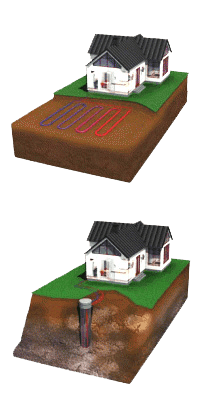
Ground Source Heat Pumps use a buried ground loop that transfers heat from the ground into the building.
Heat supplied by the NIBE Ground Source Heat Pumps that we install will provide all of the hot water and space heating requirements for your home. Solo can take the installation of ground source heat pumps right from the early ground survey stages, through to the end commissioning of the ground source the heat pump unit.
The efficiency of ground source heat pumps is measured by the coefficient of performance (CoP). This is the ratio of units of heat output for each unit of electricity used to drive the compressor and heat pump. An average CoP for a NIBE ground source heat pump is 4.5- 5.0. This means that for every unit of electricity used to power the Ground Source Heat Pump, around five units of heat are produced making it an extremely efficient way of heating a building.
To keep the efficiency of ground source heat pumps as high as possible we always aim to use underfloor heating throughout the entire house. Underfloor heating works well with ground source heat pumps as it requires a lower operating temperature.
Heating System
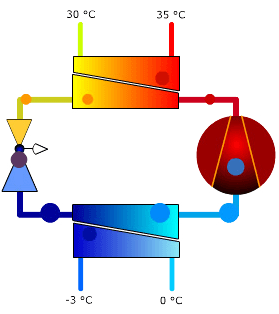
Cold Fluid from Collectors
If grid electricity is used for the ground source heat pump system you should consult a range of energy suppliers to benefit from the lowest running costs, for example by choosing an economy 10 or economy 7 tariff.
Contrary to popular belief, NIBE Ground Source Heat Pumps installed by Solo Heating Installations run completely silently. The previous 1140 models were one of the quietest heat pumps on the market, the new 1145 ground source heat pumps run with no noise at all! Its impossible to tell whether the compressor is on or not, and we invite anyone worried about the sound to come and see one in action for themselves.
Image left; Shows the incoming brine from the ground loops passing its heat to the refrigerant system. This refrigerant is then compressed with the resulting heat from that process being passed to the central heating system.
The typical cost for a ground source heat pump installation in a new property is £16,500. All systems we quote will come with an energy savings and running cost comparison sheet; which takes into account all variables to give an extremely accurate prediction on the eventual savings.
Against an existing oil, LPG or electricity system, ground source heat pumps have proven to have excellent payback periods, usually less than 4 years. Although costly to initially install, ground source heat pumps offer the long term savings due to the systems lasting for 25 + years. Payback periods are constantly lowering as gas prices continue to rise, whereas electricity prices are set to fall due to investment in renewable electricity production. For these reasons we are seeing an ever increasing popularity for the ground source heat pump systems.
Ground source heat pump collector systems fall into four categories:
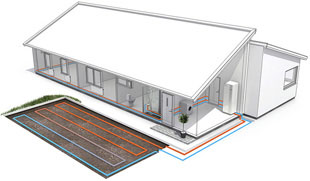
*Ground Source Heat Pump - Horizontal Loop Diagram
Horizontal Loop - Ground Source Heat Pumps
These are used when you have space in your garden to lay the pipes horizontally through the ground. Trenches are dug around 1.2m in depth and 250mm - 400mm wide. The collector pipes are then laid into these trenches and back filled with the removed earth. Trenches must be a minimum of one metre apart and one metre from any foundations or building services. The average property requires 400 metres of pipe, therefore 400 sq metres of land for the trenches.
The trenches must be the same length to ensure equal pressure drops across the collector system. The surface above the collectors should not be built on, and we supply a plan which shows the location of the pipes in the ground. The collectors link back to the ground source heat pump in your home.
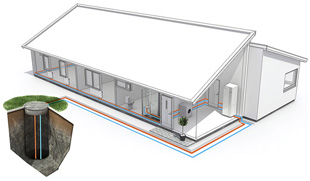
*Ground Source Heat Pump - Bore Hole Diagram
Vertical Bore Hole Loop - Ground Source Heat Pumps
Bore holes are dug into the ground, normally around 90 metres deep. It is common to have two bore holes dug to supply one home. The holes are roughly 200mm wide and must be kept at least ten metres apart from each other. A loop is lowered into the borehole with a weight to ensure it reaches the bottom of the hole. The hole is then backfilled with a grout mixture which allows easy heat transfer from ground to pipe. The loop is linked back to the ground source heat pump unit in your home.
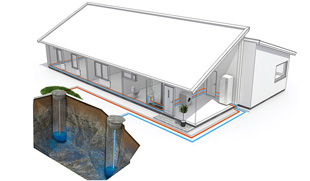
*Ground Source Heat Pump - Open Loop Diagram
Open Loop Bore Hole Systems - Ground Source Heat Pumps
A separate extraction and discharge bore well is dug into the ground. One will extract water from the underground water table and one will discharge that same water back into the ground after it has passed through the heat pumps heat exchanger. Special design considerations are given to avoid a flow short-circuit and flow direction must be taken into account as well.
Because the extracted water is not contaminated in any way, these systems often combine the extraction-well with a well-pump to allow free drinking water for the property. These systems dont always offer the lowest runnings costs as you have to run a large water well pump at the same time as the GSHP itself.
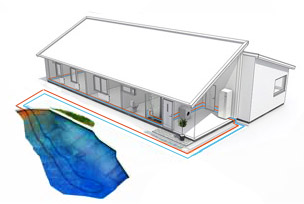
*Ground Source Heat Pump - Open Loop Diagram
Open Loop Water Source - Ground Source Heat Pumps
This system extracts and then re-discharges water from a nearby stream or river. Properties with a large pond or lake can also use this system, as it takes in water from the source and uses the energy in that water to power the heat pump. These systems are similar to the 'well' type open loop systems. It is possible to see CoP's in excess of 5, but we must consider the electrical energy to run the water pump in addition to the ground source. Sometimes when water permits are harder to come by, we actually lower a compact collector into the water, thus not extracting and therefore not requiring a license from the Environmental Agency.
Things to consider:
You will need space outside your house for the ground loop. If you can't fit a ground loop on your land, you can consider boreholes. Boreholes are dug around 90 metres into the earths surface and the loop is lowered Ground Source Heat Pumpsdown into it. Borehole type designs work more efficiently than the area loop design because of more stable temperatures all year round lower in the earths crust.
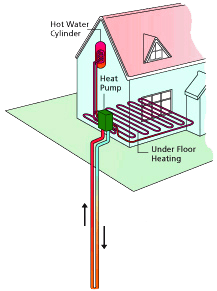
The ground needs to be suitable to transfer heat into the pipes used for ground source heat pumps. Hard rocky ground isn't as efficient but still works well. Wet soil type ground or free flowing water works extremely efficiently as the moisture conducts heat freely to the looped collectors. Depending on the ground type we will have to increase or decrease the length of the loop to compensate.
Underfloor heating will ideally be used throughout the house and pipe centres will need to be slightly shorter to keep the efficiency of the ground source heat pump high. Radiators can be used upstairs but the CoP will reduce.
For installations over 12kw, Ground Source Heat Pumps installed by Solo Heating Installations will require a 3-phase electrical supply. Below 12kw will only require a normal single phase supply as the NIBE units installed by Solo use soft start mechanisms.
When used to heat hot water, a thermal store will need to be installed. If you are only supplying the heating through the ground source heat pump, a buffer tank will be installed as well.
Some other manufacturers of ground source heat pumps require immersion heaters to supplement the hot water production. This is because hot water temperatures need to be kept at around 57 degrees C. The NIBE ground source heat pumps that we install can output temperatures up to 65 degrees C, which is comfortably enough to maintain hot water temperatures. Immersion heaters would only be used if there was a need for an anti-legionella cycle on the system. In this instance the immersion heater would come on for about 10 minutes every 2 weeks just to kill off any potential legionella risk.
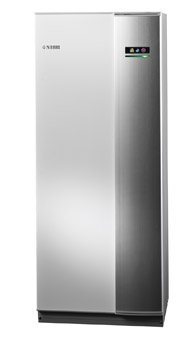
NIBE 1145 Ground Source Heat Pump
Your energy consumption for heating will be lowered by up to 80% with the use of the new 1145 NIBE ground source heat pumps.
NIBE produce 15 different types of Ground Source Heat Pumps, ranging from 5kW to 60kW. By using a cascade connection it is possible to achieve an output of 540kW. The heat pump will be sized exactly to the heating requirement for your home; which will ensure no startup cycling during its operational life.
The energy consumption for heating and hot water can be lowered by up to 80% in comparison to heating systems using fossil fuels.
NIBE FIGHTER 1145 is a ground source heat pump for heating small and large houses.
NIBE FIGHTER 1145 ground source heat pumps are equipped with a control panel that offers the homeowner easy to use functions on the heat pump.
- NIBE's modern scroll compressor means the heat pump runs silently during operation, something not seen on a heat pump before.
- Large control panel on the front of the unit for ease of use by the end user.
- Double heat curves which increases the efficiency of the unit, compared to other available models.
- Outdoor weather compensation control allows a total energy efficient running cycle. The ground source heat pump adjusts its output compared to the outside temperature; this ensures the most economical operation of the heat pump throughout the year.
- Soft start fitted to all NIBE ground source heat pumps as standard. This ensures on startup of the heat pump the current drawn from the electrical supply doesn't affect the rest of the properties supply.
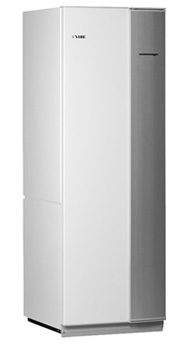
NIBE 1245 Ground Source Heat Pump
The NIBE 1245 ground source heat pump system is suitable for small family homes, with average demands for hot water.
They come with an inbuilt hot water heating system and electric immersion heater backup. The tank in tank heating system for hot water ensures the entire 180 litre hot water tank comes to temperature in the fastest time, and by mixing the hot water down to useable temperatures through a blending valve, the actual useable storage volume increases to around 200 litres.
- Features an in built hot water cylinder, which is capable of proving hot water for most 2 to 3 bedroom homes.
- The unit can be connected to two different heating temperature zones. This would include a radiator system and underfloor heating circuit.
- In-built immersion heaters come on automatically under extreme loading conditions. These are pre-programmed to work with the ground source heat pumps in the most efficient and economical way.
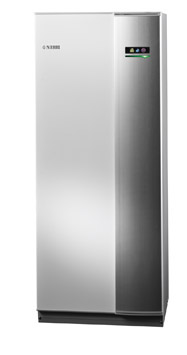
NIBE 1345 Ground Source Heat Pump
Introducing the new 1345 NIBE Ground Source Heat Pump, the replacement for the 1330 Unit.
With its two large scroll compressors, NIBE F1345 is the ideal ground source heat pump for multi-occupancy buildings, industrial premises, churches and other buildings with a large heat demand. The heat pump compressors collaborate and engage as necessary, give better power control, less wear and greater operational ability.
The new F1345 Ground Source Heat Pump is more flexible than ever and with its advanced control system it can be adapted to several system solutions. In systems with up to 9 heat pumps and with a wide range of accessories e.g. for control of oil, gas, pellet fired or electric boilers, you find the full flexibility for your installation.
NIBE F1345 is equipped with a multicolour display, multi languages support and simply upgradable software via the built in USB port.
NIBE F1345 is manufactured in four sizes; these feature outputs of 24, 30, 40 and 60 kW.
The NIBE 1345 Ground Source Heat Pump is designed for buildings with large heating requirements. These heat pump units require 3-phase electrics, and house twin scroll compressors for greater efficiency during operation.
Outlined below are some of the many upgrades possible to the ground source heat pump system's Solo install.
NIBE 30/40 FLM Exhaust Air Module

This unit is the ideal solution in new buildings to meet the energy savings directive, and renovated buildings to eliminate issues with ventilation. It combines heat recovery ventilation with the ground source heat pump unit to increase the total system efficiency, and ventilate the stale air areas of your home. Air is extracted from the bathrooms, kitchen and even pool areas; this air is taken back to the air module where the energy is extracted. This energy is then given directly to the incoming brine from the ground loops, thus increasing the incoming temperature and the systems efficiency.

NIBE 10/20 PKM Passive Cooling Module
The PKM unit will allow free cooling of a property over a suitable surface area. Heat will be taken from a space through underfloor heating or fancoils to actively cool an area down in the summer. The unit can actively cool a house down whilst still providing hot water supplies through a separate heating coil.
NIBE HPAC Cooling/Heating System

The HPAC unit will turn a NIBE 1145 / 1245 and 1330 ground source heat pump into a complete climate controlled system. Heat energy will be taken from rooms during the summer through the underfloor heating or air-conditioning system. This energy is transferred through the ground coils into the earths soil. This charging effect during the year increases the systems efficiency during the winter as the stored energy in the ground is taken for use. Solo Heating Installations would recommend this upgrade for large houses or large surface area rooms in conjunction with underfloor heating.
Swimming Pool Heating with Ground Source Heat Pump
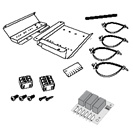
We can dock and heat a swimming pool with a ground source heat pump. Swimming pools can be costly to heat throughout the year, and ground source units will reduce costs significantly. Depending on different factors, such as whether the pool is covered or in a heated building, we will work out the heat load requirements for the pool. The pool heating requirements are then taken into account when designing and sizing the ground source heat pump. The ground source heat pump will provide heating up to a stainless steel heat exchanger installed in-line with the actual swimming pool water. This ensures no contamination to the pool or heating system. The ground source unit will be programmed with a timer to ensure the pool is only heated when necessary.
Solar Thermal Panels with a Ground Source Heat Pump
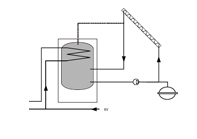
Solar thermal panels can be docked with ground source heat pump systems. The hot water cylinder will need to be upgraded with a separate solar coil, which allows a sealed solar panel circuit with its own specialist antifreeze to join into the system. NIBE provide a solar coil cylinder, which holds a total hot water volume of 300 litres, and an outer jacket volume of 450 litres. This allows safe docking and efficient operation of multiple panels, giving large amounts of hot water throughout the year. A full solar panel suitability assessment will be completed at the design stage.
Exhaust Air Heat Pump Docking to Ground Source Heat Pumps

Ground source heat pumps can even be docked to exhaust air heat pump units. The exhaust air heat pump will extract stale air, and transfer its energy through heat pump technology to its own hot water heating system. The ground source heat pump is therefore used to provide space heating through the use of underfloor heating or radiators. If the exhaust air heat pump cannot cope with the demand for hot water, the ground source heat pump gives an extra boost energy. These systems will provide a fully ventilated and heated property, and will have extremely low annual running costs.
Heat Recovery System Free Cooling with Ground Source Heat Pump
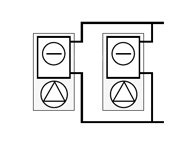
Free cooling to a heat recovery ventilation system can be achieved with a groundGround Source Heat Pump and Heat Recovery System Free Cooling source heat pump using a ground loop or boreholes as a heat source. The incoming air supply to the heat recovery unit will have a water to air fan coil heat exchanger installed. These heat exchangers are custom built for every property and will allow the ground loop brine to pass through the heat exchanger and passively cool the air coming into the house through the heat recovery system. Expect to see a 3- 6 degree C temperature drop in the incoming heat recovery air. The free cooling system is controlled by a thermostat inside the property, this ensures free cooling is only activated at a pre-determined temperature. This upgrade will cost in the region of £1,500.00 to install, but it will provide powerful cooling at the cost to run a circulating pump (0.2p per hour).
Ground Source Heat Pump Grants
Since the launch of the RHI Renewable Heat Incentive Scheme, grants have become available for both ground source and air source heat pumps.
Solo Heating Installations are MCS accredited installers, which means that we are able to offer annual grants to our customers. Upon installation of the ground source heat pump, an energy meter and/or energy calculation will be made based on the total annual Kwh output of the ground source appliance. The annual Kwh production of the ground source heat pump will be multiplied by a pence per Kwh figure and this will form the annual grant payment.
The annual grant scheme is set to boost investment in the ground source heat pump sector, as with the feed in tariff scheme run with solar PV. The annual grants will make the installation of a ground source heat pump very cost effective, as the running costs are already very low, plus homeowners will have the benefit of receiving a grant on their ground source heat pump as well.


